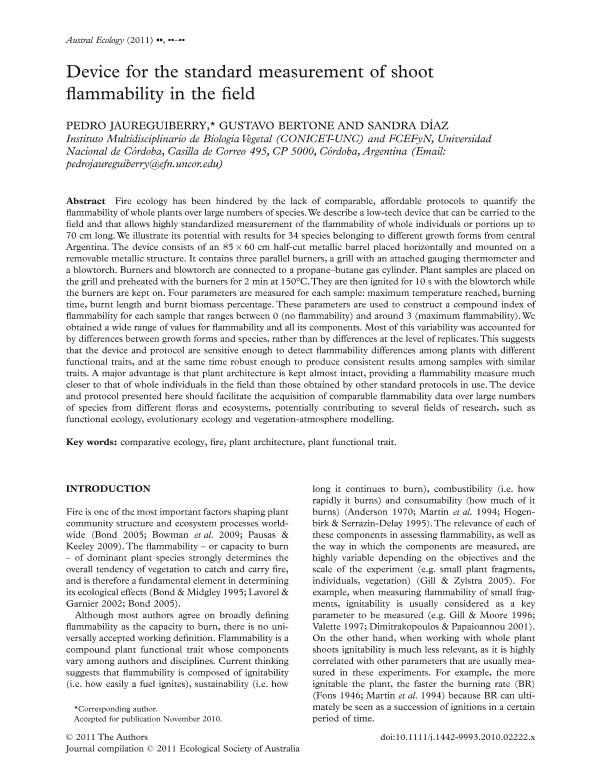Mostrar el registro sencillo del ítem
dc.contributor.author
Jaureguiberry, Pedro

dc.contributor.author
Bertone, Gustavo Alejandro

dc.contributor.author
Diaz, Sandra Myrna

dc.date.available
2017-02-17T19:47:57Z
dc.date.issued
2011-11
dc.identifier.citation
Jaureguiberry, Pedro; Bertone, Gustavo Alejandro; Diaz, Sandra Myrna; Device for the standard measurement of shoot flammability in the field; Wiley; Austral Ecology; 36; 7; 11-2011; 821-829
dc.identifier.issn
1442-9985
dc.identifier.uri
http://hdl.handle.net/11336/13163
dc.description.abstract
Fire ecology has been hindered by the lack of comparable, affordable protocols to quantify the flammability of whole plants over large numbers of species.We describe a low-tech device that can be carried to the field and that allows highly standardized measurement of the flammability of whole individuals or portions up to 70 cm long.We illustrate its potential with results for 34 species belonging to different growth forms from central Argentina. The device consists of an 85 ¥ 60 cm half-cut metallic barrel placed horizontally and mounted on a removable metallic structure. It contains three parallel burners, a grill with an attached gauging thermometer and a blowtorch. Burners and blowtorch are connected to a propane?butane gas cylinder. Plant samples are placed on the grill and preheated with the burners for 2 min at 150°C.They are then ignited for 10 s with the blowtorch while the burners are kept on. Four parameters are measured for each sample: maximum temperature reached, burning time, burnt length and burnt biomass percentage. These parameters are used to construct a compound index of flammability for each sample that ranges between 0 (no flammability) and around 3 (maximum flammability).We obtained a wide range of values for flammability and all its components. Most of this variability was accounted for by differences between growth forms and species, rather than by differences at the level of replicates.This suggests that the device and protocol are sensitive enough to detect flammability differences among plants with different functional traits, and at the same time robust enough to produce consistent results among samples with similar traits. A major advantage is that plant architecture is kept almost intact, providing a flammability measure much closer to that of whole individuals in the field than those obtained by other standard protocols in use. The device and protocol presented here should facilitate the acquisition of comparable flammability data over large numbers of species from different floras and ecosystems, potentially contributing to several fields of research, such as functional ecology, evolutionary ecology and vegetation-atmosphere modelling.
dc.format
application/pdf
dc.language.iso
eng
dc.publisher
Wiley

dc.rights
info:eu-repo/semantics/openAccess
dc.rights.uri
https://creativecommons.org/licenses/by-nc-sa/2.5/ar/
dc.subject
Comparative Ecology
dc.subject
Fire
dc.subject
Plant Architecture
dc.subject
Plant Functional Trait
dc.subject.classification
Ecología

dc.subject.classification
Ciencias Biológicas

dc.subject.classification
CIENCIAS NATURALES Y EXACTAS

dc.title
Device for the standard measurement of shoot flammability in the field
dc.type
info:eu-repo/semantics/article
dc.type
info:ar-repo/semantics/artículo
dc.type
info:eu-repo/semantics/publishedVersion
dc.date.updated
2017-02-14T14:34:46Z
dc.identifier.eissn
1442-9993
dc.journal.volume
36
dc.journal.number
7
dc.journal.pagination
821-829
dc.journal.pais
Reino Unido

dc.journal.ciudad
Londres
dc.description.fil
Fil: Jaureguiberry, Pedro. Consejo Nacional de Investigaciones Científicas y Técnicas. Centro Científico Tecnológico Córdoba. Instituto Multidisciplinario de Biología Vegetal (p); Argentina. Universidad Nacional de Córdoba; Argentina
dc.description.fil
Fil: Bertone, Gustavo Alejandro. Consejo Nacional de Investigaciones Científicas y Técnicas. Centro Científico Tecnológico Córdoba. Instituto Multidisciplinario de Biología Vegetal (p); Argentina. Universidad Nacional de Córdoba; Argentina
dc.description.fil
Fil: Diaz, Sandra Myrna. Consejo Nacional de Investigaciones Científicas y Técnicas. Centro Científico Tecnológico Córdoba. Instituto Multidisciplinario de Biología Vegetal (p); Argentina. Universidad Nacional de Córdoba; Argentina
dc.journal.title
Austral Ecology

dc.relation.alternativeid
info:eu-repo/semantics/altIdentifier/url/http://onlinelibrary.wiley.com/doi/10.1111/j.1442-9993.2010.02222.x/abstract
dc.relation.alternativeid
info:eu-repo/semantics/altIdentifier/doi/http://dx.doi.org/10.1111/j.1442-9993.2010.02222.x
Archivos asociados
